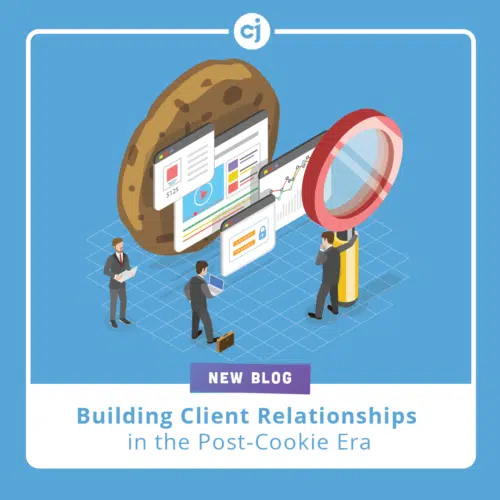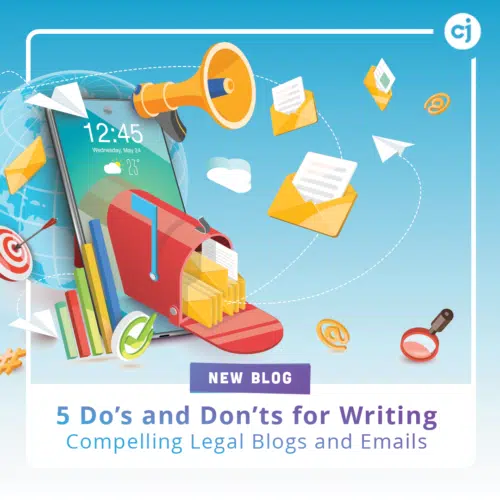At cj Advertising, we’ve helped personal injury law firms dominate their markets since 1994. In that time, our expertise has extended into the realm of digital marketing.
With more than 300 million regular internet users in the U.S. alone as of 2023, digital marketing has become an essential marketing strategy for law firms wanting to connect with potential and current clients. But with so many firms out there vying for those same potential clients, the competition is tough.
Law firms face several key challenges when trying to create effective digital marketing campaigns, including:
- Standing Out: It’s hard for a law firm to get noticed when so many others offer similar services.
- Building Trust and Credibility: Potential clients need to believe in a law firm’s ability to help them effectively.
- Reaching Different People: Law firms must communicate in ways that connect with various groups of people.
Email marketing is one of the most effective ways to meet, address, and overcome those challenges.
How can email marketing benefit your firm?
- Boost Visibility: Regular emails keep a law firm in the public eye, helping them to be more recognized.
- Enhance Communication: Email allows for direct, personal interaction with clients, fostering a stronger connection.
- Target the Right Clients: Email marketing can focus on people most likely to need the firm’s services.
- Save Money: Email is a cost-effective marketing strategy, and it offers a high impact at a low cost.
Understanding Email Marketing
Email marketing is a way of reaching out to people through email. It’s about sending messages, updates, or promotional material to a list of subscribers who have chosen to receive this information. The main goal is to engage with potential or current clients by providing valuable content, updates about your services, or exclusive offers.
If you’re looking to launch an email marketing campaign, this brief overview of the process can help you get started:
- Building an Email List: This involves collecting email addresses from people interested in your services. They might sign up through your website, at an event, or in your office. The key is that they agree to receive emails from you.
- Creating and Sending Campaigns: This step involves making and sending emails. These can be newsletters, updates about your services, or promotional offers. The content should be exciting and relevant to keep your audience engaged, even when they may not need your services at this moment.
- Avoiding Spam: Your emails should never feel like spam. They should be relevant and valuable to the reader. Also, you must follow best practices about email marketing, which require that people have opted in to receive your emails and can easily unsubscribe if they want to.
- Analyzing and Refining: After sending emails, looking at how they performed is essential. This means checking how many people opened the email and clicked on links. Based on this information, you can make changes to improve future emails.
Building a Thriving Email List
A high-quality email list is vital for effective email marketing. Here’s why it’s important:
- Targeted Audience: A good list consists of potential clients genuinely interested in legal services. This means your emails are more likely to be read and acted upon.
- Segmented Communication: By categorizing your list (for example, by different practice areas or demographics), you can tailor your emails to fit specific groups. This leads to better engagement as the content is more relevant to each segment.
How can you grow your firm’s email marketing list?
- Website Opt-in Forms: Use clear and straightforward forms on your website where visitors can sign up to receive emails. Make sure these forms are easy to find and use.
- Lead Magnets and Free Offers: Provide something valuable in exchange for email addresses. This could be a free legal guide, a webinar, or a consultation. It’s a way to offer immediate value while building your list.
- Client Intake Forms: When new clients sign up for your services, include an option for them to join your email list. This leverages your existing client interactions.
- Social Media Promotions and Contests: Use your social media platforms to promote sign-ups. Running contests or promotions that require an email entry can also be an effective way to grow your list while building relationships and brand awareness within your community.
- Offline List Acquisition: Partner with local businesses or organizations to reach a wider audience. This could involve joint events or promotions where you can collect email addresses in person.
Email Segmentation for Targeted Campaigns
Email segmentation is about splitting your email list into smaller, more specific groups. This way, you can send more relevant and personalized messages to each group. It’s like having different conversations with different people based on what you know they’re interested in.
Here are a few email list segmentation opportunities you can take advantage of:
- By Case Type: People have different legal needs. Some might be seeking a lawyer after a car crash, while others need information on medical malpractice to determine if they have a case. By segmenting your list this way, you can send car accident-related content to those who need it and medical malpractice information to others.
- Geographic Location: Laws and legal issues can vary by location. Segmenting your list by where people live lets you send them information relevant to their specific area. For example, you might send different advice to someone in a big city versus someone in a rural area.
- Client Lifecycle Stage: Where someone is in their journey with your firm matters. New leads might need introductory information about your services while existing clients might appreciate updates or advanced legal tips. Segmenting by lifecycle stage helps you send the right message at the right time.
- Demographics and Interests: People’s age, gender, and personal interests can influence what kind of legal information they find helpful. Considering these factors, you can tailor your emails to their specific circumstances and interests.
Leveraging Automation for Efficiency
Email automation tools are handy for streamlining tasks that would otherwise take time, such as:
- Automating Repetitive Tasks: Things like sending out welcome emails or appointment reminders can be set up once and then run automatically. This saves time because you don’t have to do these tasks manually each time.
- Personalizing Communication: These tools can send emails based on specific actions or behaviors of clients. For example, if someone signs up for a newsletter, they automatically get a welcome email.
- Freeing Up Time: By handling routine communication, email automation lets law firm staff focus on more critical tasks like client consultations and case preparations.
What are some examples of email automation put into practice by law firms?
- Welcome Emails: When a new client signs up, an automated email series can introduce them to your firm, explain what they can expect, and provide helpful resources.
- Birthday and Anniversary Greetings: Sending personalized greetings on special occasions like birthdays or the anniversary of a client signing up with your firm can strengthen client relationships.
- Re-engagement Campaigns: For potential clients who haven’t interacted with your firm in a while, automated emails can be sent to rekindle their interest.
Tracking and Measuring Success
Tracking and analyzing email marketing performance is vital for understanding how well your campaigns work. Doing so can help with the following:
- Identifying Strengths and Weaknesses: By looking at how different emails perform, you can see what types of messaging are working and what are not. This helps in refining your strategy.
- Making Data-Driven Decisions: Instead of guessing, you use actual data from your email campaigns to make informed decisions about future strategies.
- Demonstrating ROI: Tracking performance helps you understand the return on investment of your email marketing efforts. This shows how much value email marketing is adding to your firm.
When deploying an email marketing campaign, it’s important to monitor these metrics to track its success over time:
- Open Rates and Click-Through Rates: These tell you how many people are opening your emails and engaging with the content by clicking links. High rates indicate good engagement.
- Unsubscribe Rates and Bounce Rates: A high unsubscribe rate might suggest your content isn’t resonating with your audience. Bounce rates indicate how many emails are not being successfully delivered—for example, your email list may contain inactive or invalid email addresses.
- Conversion Rates and Lead Generation: This shows how effectively your emails turn readers into clients or leads. It directly measures your email campaign’s effectiveness in achieving its goals.
- Website Traffic and Engagement: Look at how your email campaigns drive traffic to your website and what users do once they get there. This can be tracked using tools like Google Analytics.
- Return on Investment (ROI): This is about understanding the financial return you get from your email marketing campaigns compared to your spending on them.
Utilize Email Marketing’s Potential in Your Firm’s Marketing Strategy
Email marketing offers several key benefits and effective strategies for personal injury law firms:
- Increased Brand Awareness and Lead Generation: Regular emails keep your firm top of the mind for current and potential clients. They help generate new leads by reaching out to people interested in your services.
- Enhanced Client Communication and Engagement: Email allows for direct, personalized communication with clients and potential clients. This helps build stronger relationships and keeps clients informed and engaged with your firm.
- Targeted Messaging for Improved Results: By segmenting your email list and tailoring messages to specific groups, your firm can send more relevant information to different audiences, leading to better engagement and outcomes.
- Cost-Effective and Measurable: Email marketing is one of the most affordable marketing channels. It also allows easy tracking of metrics like open rates, click-through rates, and conversions to see how well your campaigns perform.
Integrating email marketing into your personal injury law firm’s marketing strategy can significantly enhance your outreach and client relationships. It’s a powerful tool that can drive growth and provide measurable results.
Don’t miss the opportunity to connect more effectively with your clients and expand your firm’s reach. Start implementing email marketing in your firm’s marketing strategy today by reaching out to your cj brand strategist. It’s time to harness the power of email to grow your practice and dominate your market.


